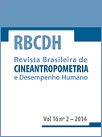Componente lento da cinética do VO2: determinantes fisiológicos e implicações para o desempenho em exercícios aeróbios
DOI:
https://doi.org/10.1590/1980-0037.2014v16n2p233Resumo
A cinética do consumo de oxigênio (VO2) e a resposta do lactato sanguíneo durante o exercício de carga constante em diferentes intensidades permitem caracterizar os domínios moderado, pesado e severo do exercício. Em exercício de intensidade constante, o perfil da resposta do VO2, analisada por ajustes exponenciais, apresenta as fases cardiodinâmica, fundamental e lenta. A ocorrência do componente lento (CL) tem sido associada a fatores como recrutamento de fibras do tipo II e acúmulo de metabólitos, como lactato, íons H+, fosfato inorgânico e ADP. O CL expressa uma redução da eficiência muscular e tem sido associado à menor tolerância de exercícios aeróbios de intensidade alta. O presente estudo teve por objetivo detalhar a fundamentação teórica sobre sua ocorrência, a influência na tolerância ao exercício, bem como prover os diferentes pro-cedimentos adotados em sua quantificação.
Downloads
Publicado
Edição
Seção
Licença

Direitos Autorais para artigos publicados nesta revista são do autor, com direitos de primeira publicação para a revista. Em virtude da aparecerem nesta revista de acesso público, os artigos são de uso gratuito, com atribuições próprias, em aplicações educacionais e não-comerciais, desde que seja dada a atribuição. Esta obra foi licenciada com uma Licença Creative Commons Atribuição 4.0 Internacional - CC BY


